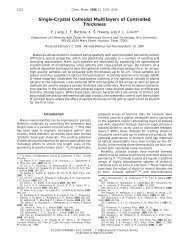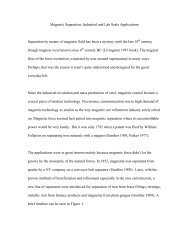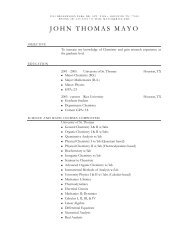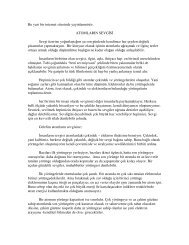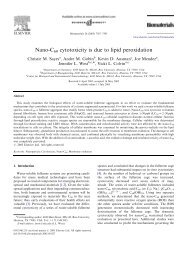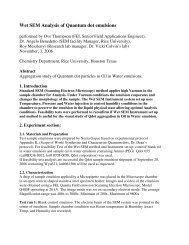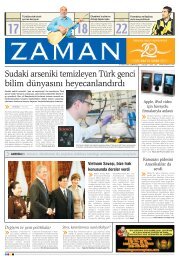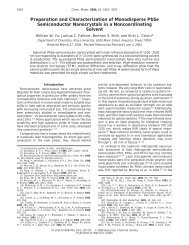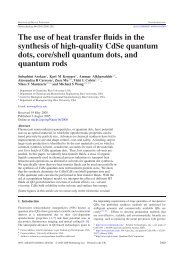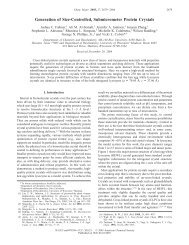Figure 4. Sizing by TEM. Measurements were taken on the longest axis <strong>of</strong> at least 150 isolated particles. (A) Fraction 1 (retained from glass fiber prefilter) has an average size <strong>of</strong> 440 ( 228 nm. (B) Fraction 2 (filtered through 1.2 µm nylon paper, pellet after 20 min at 3313 G) has an average size <strong>of</strong> 84 nm and a size distribution from 1 to 175 nm. (C) Fraction 3 (filtered through 1.2 µm nylon paper, supernatant after 2 min at 3313 G) has an average size <strong>of</strong> 37 nm and a distribution from 1 to 83 nm. (D) Fraction 4 (the same sample as Figure 3B; filtered through 0.2 mm nylon paper, supernatant after 8 min at 3313 G) has an average size <strong>of</strong> 18 nm ( 5 nm. Reaction conditions were identical to Figure 1. All samples were dialyzed, concentrated and coarse paper filtered. Fractions 2-4 were also filtered over a glass fiber prefilter prior to further filtration as above. in electron microscopes, forming silicon quite readily. 35-37 We found that the d spacing <strong>of</strong> the planes in high resolution images matched equally well to silicon as they did to quartz. We also found a weak reflection in the SAED that indexed to the Si 100 planes, but no evidence <strong>of</strong> silicon in X-ray diffraction data. X-ray diffraction collected using a synchrotron X-ray source confirms the presence <strong>of</strong> nanocrystalline quartz. Samples were dried for synchrotron powder XRD, and the resulting reflections exhibit line broadening. The line widths for the (100) and (101) reflections <strong>of</strong> quartz are broadened considerably (Figure 5) in the smaller samples, to 0.18 and 0.20 degrees, respectively, as compared to the larger fractions in which peaks are narrowed to the instrumental resolution limit <strong>of</strong> 0.08 degrees measured using LaB6 (NIST standard). Scherrer analysis <strong>of</strong> the d100 peaks finds a grain size <strong>of</strong> 28 nm for fraction 3. The reasonably good agreement between this grain size and the statistical particle size (37 nm) determined by TEM shown in Figure 4 is evidence that these small particles are indeed nanocrystalline quartz. Additionally, the agreement between the TEM and XRD grain size determinations suggests that particle defects and grain boundaries are not extensive in these materials. An analysis <strong>of</strong> this X-ray diffraction data, and its changes under pressure, are the subject <strong>of</strong> another publication. 38 In this approach to forming nanoscale quartz, we sacrifice sample yield for phase purity and small size. While the yield <strong>of</strong> submicron quartz is ∼90%, we typically recover less than 50 mg <strong>of</strong> solid material in our nanoscale fractions after Figure 5. Sizing by XRD. (A) d101 peaks <strong>of</strong> the first three fractions shown in Figure 4. (B) d100 peaks <strong>of</strong> the same fractions. O, fraction 1; +, fraction 2; [, fraction 3. Both d101 and d100 for fractions 1 and 2 are limited in peak width by the instrumental resolution. Scherrer analysis <strong>of</strong> fraction 3, d100 peak width gives a grain size <strong>of</strong> 28 nm while the d101 peak gives a grain size <strong>of</strong> 25 nm. 34 combining product from several reactions. One reason this value is so low is the inefficiency <strong>of</strong> filtration; we lose many small particles during this step and a size selective precipitation scheme could provide one solution. 39 Colloidal silica has been shown to exhibit solute-dependent coagulation, which could be exploited in such a strategy. 29 Alternatively, quartz growth may be limited during the reaction through the addition <strong>of</strong> excess base. Existing data on the formation <strong>of</strong> zeolite colloids that form in hydrothermal reactors through precipitation <strong>of</strong> silicates suggest that excess OH - enhances redissolution and retards the grain growth <strong>of</strong> aluminosilicates such as ZSM-5. 40 We find that increasing NaOH content substantially in this reaction yields complex silicate phases instead <strong>of</strong> quartz. Other bases, which do not contribute Na + to the reaction, may prove to be more useful. Given the general success <strong>of</strong> hydrothermal methods in forming other nanoscale ceramics without size selection, it is useful to consider why quartz generates larger crystallites relative to other oxides such as titania. Reported surface energies for quartz range from 50 to 300 mJ/m 2 as compared to rutile and anatase TiO2, which are 1.91 mJ/m 2 for rutile and 1.32 mJ/m 2 for anatase. 8,41,42 These high surface energies slow the homogeneous nucleation <strong>of</strong> quartz relative to titania. 43 Thus, the precipitation <strong>of</strong> quartz occurs after a long 658 Nano Lett., Vol. 3, No. 5, 2003
delay during which the solution becomes supersaturated with silica (10 mg/mL as compared to the equilibrium solubility <strong>of</strong> 1 mg/mL at 300 °C), which enhances particle growth substantially. 29 Even if the solution were not saturated, crystal growth would occur quite rapidly. One report cites the growth rate for a large single crystal <strong>of</strong> quartz (in approximately 1.3 mg/mL aqueous silica, 263 °C) as 0.74 mm/day or 500 nm/min. 14 This value is comparable to the initial growth seen in the method we report where individual particles sizes reach 500 nm in roughly five minutes. In contrast, growth rates for hydrothermally synthesized TiO2 nanoparticles are only a few Å/hr. 44 While the growth rates for single crystals can be quite different from the rates for powders, this comparison indicates why one would expect the hydrothermal precipitation <strong>of</strong> quartz to be very different from other ceramic materials. We present the first report on the synthesis <strong>of</strong> nanoscale R-quartz. Isolated crystallites with characteristic nanoscale properties have been prepared by hydrothermal treatments <strong>of</strong> amorphous silica precursors. <strong>Quartz</strong> nanoparticles are isolated from polydisperse submicron quartz powders by pH controlled dialysis, filtration, and centrifugation. The average particle size and size distribution are significantly improved by this treatment. The smallest fraction isolated exhibits an average grain size <strong>of</strong> 18 nm with a size distribution <strong>of</strong> 5 nm. It is apparent from line broadening in X-ray diffraction that the average domain size <strong>of</strong> the nanocomponent is well below 100 nm. Scherrer analysis proves that quartz with average grain sizes below 37 nm can be formed. Furthermore, transmission electron microscopy and selected area electron diffraction show evidence <strong>of</strong> isolated quartz nanocrystals with an average size <strong>of</strong> 18 nm and a relatively narrow size distribution <strong>of</strong> 28%. Acknowledgment. We thank Dr. Simon Clark and Mr. Stephen Prilliman, <strong>of</strong> Lawrence Berkeley Laboratories and UC Berkeley, respectively, for their assistance with synchrotron X-ray diffraction data. We acknowledge the National Center for Electron Microscopy at Lawrence Berkeley Laboratories for facilities useful for high resolution imaging <strong>of</strong> quartz nanocrystals. This work was supported by a Research Corporation Research Innovation Award, grant CHE-0103174 from the National Science Foundation, and the Robert A. Welch Foundation grant C-1342. Supporting Information Available: Experimental details including dialysis purification, filtration, soluble silica concentration measurements, X-ray powder pattern collection and analysis, microscopy and energy-dispersive X-ray analysis; high-resolution transmission electron micrographs <strong>of</strong> fraction 4. This material is available free <strong>of</strong> charge via the Internet at http://pubs.acs.org. References (1) Mason, B.; Berry, L. G. Elements <strong>of</strong> Mineralogy; W. H. Freeman: San Francisco, 1968. (2) Binggeli, N.; Chelikowsky, J. R. Nature 1991, 353, 344. (3) Gillet, P. Phys. Chem. Minerals 1996, 23, 263. (4) Hervey, P. R.; Foise, J. W. Miner. Metallur. Proc. 2001, 18, 1. (5) Kingma, K. J.; Meade, C.; Hemley, R. J.; Mao, H. K.; Veblen, D. R. Science 1993, 259, 666. (6) McHale, J. M.; Auroux, A.; Perrotta, A. J.; Navrotsky, A. Science 1997, 277, 788. (7) Chun, C. C.; Herhold, A. B.; Johnson, C. S.; Alivisatos, A. P. Science 1997, 276, 398. (8) Zhang, H.; Banfield, J. F. J. Mater. Chem. 1998, 8, 2073. (9) Rios, S.; Salje, E. K. H.; Redfern, S. A. T. Euro. Phys. J. B 2001, 20, 75. (10) Ullman, W. J.; Kirchman, D. L.; Welch, S. A.; Vandevivere, P. Chem. Geo. 1996, 132, 11. (11) Bennet, P. C.; Melcer, M. E.; Siegel, D. I.; Hassett, J. P. Geochem. Cosmochem. Acta 1988, 52, 1521. (12) Varshneya, A. K. Fundamentals <strong>of</strong> Inorganic Glasses; Academic Press: San Diego, 1994. (13) LaMer, V. K.; Dinegar, R. H. J. Am. Chem. Soc. 1950, 72, 4847. (14) Christov, M.; Kirov, G. C. J. Cryst. Growth 1993, 131, 560. (15) We use the definition <strong>of</strong> “nano” to mean d < 100 nm (as given in: Roco, M. C.; Williams, S.; Alivisatos, A. P. Nanotechnology Research Directions: IWGN Workshop Report; WTEC, Loyola College Maryland, 1999) Particles from 100 to 1000 nm we refer to as submicron. (16) Basca, R. R.; Gratzel, M. J. Am. Ceram. Soc. 1996, 79, 2185. (17) Cheng, H.; Ma, J.; Zhao, Z.; Qi, L. Chem. Mater. 1995, 7, 663. (18) Xia, C. T.; Shi, E. W.; Zhong, W. Z.; Guo, J. K. J. Cryst. Growth 1996, 166, 961. (19) Balitsky, V. S.; Bublikova, T. M.; Marina, E. A.; Balitskaya, L. V.; Chichagova, Z. S.; Iwasaki, H.; Iwasaki, F. High Press. Res. 2001, 20, 273. (20) Korytkova, E. N.; Chepik, L. F.; Mashchenko, T. S.; Drozdova, I. A.; Gusarov, V. V. Inorg. Mater. 2002, 38, 227. (21) Lee, K. J.; Seo, K. W.; Y, H. S.; Mok, Y. I. Korean J. Chem. Eng. 1996, 13, 489. (22) Campbell, A. S.; Fyfe, W. S. Am. Mineral. 1960, 45, 464. (23) Fyfe, W. S.; McKay, D. S. Am. Mineral. 1962, 47, 83. (24) Corwin, J. F.; Herzog, A. H.; Owen, G. E.; Yalman, R. G.; Swinnnerton, A. C. J. Am. Chem. Soc. 1953, 73, 3933. (25) Eapen, M. J.; Reddy, K. S. N.; Shiralkar, V. P. Zeolites 1994, 14, 295. (26) Helmkamp, M. M.; Davis, M. E. Annu. ReV. Mater. Sci. 1995, 25, 161. (27) Lechert, H.; Kacirek, H. Zeolites 1993, 13, 192. (28) Lavallo, M. C.; Tsapatsis, M. AdVanced Catalysts and Nanostructured Materials; Academic Press: San Diego, 1996. (29) Iler, R. K. The Chemistry <strong>of</strong> Silica; Wiley: New York, 1979. (30) Bergna, H., Ed. The Colloid Chemistry <strong>of</strong> Silica; American Chemical Society: Washington, DC, 1994; Vol. 234. (31) Carr, R. M.; Fyfe, W. S. Am. Mineral. 1958, 43, 909. (32) Davis, M. E. Strategies for Zeolite <strong>Synthesis</strong> by Design; Elsevier Science B. V., 1995. (33) Laudise, R. A. J. Am. Chem. Soc. 1958, 81, 562. (34) Cullity, B. D. Elements <strong>of</strong> X-ray Diffraction, 2nd ed.; Addison- Wesley: Reading, 1978. (35) Ashwell, W. B.; Todd, C. J.; Heckingbottom, R. J. Phys. E 1973, 6, 435. (36) Pignatel, G. U.; Queirolo, G. Rad. Eff. 1983, 79, 291. (37) Pitts, J. R.; Czanderna, A. W. Nucl. Inst. Meth. Phys. Res. 1986, B13, 245. (38) Bertone, J. F. et al., in preparation for submistion to Phys. Rev. B. (39) Murray, C. B.; Norris, D. J.; Bawendi, M. G. J. Am. Chem. Soc. 1993, 115, 8706. (40) Yamamura, M.; Chaki, K.; Wakatsuki, T.; Okado, H. Zeolites 1994, 17, 643. (41) Janczuk, B.; Zdziennicka, B. J. Mater. Sci. 1994, 29, 3559. (42) Parks, G. A. J. Geophys. Res. 1984, 89, 3997. (43) Kashchiev, D. Nucleation: Basic Theory with Applications; Butterworth Heinemann: Oxford, 2000. (44) Yanquing, Z.; Erwei, S.; Zhizhan, C.; Wenjun, L.; Xinfang, H. J. Mater. Sci. 2000, 11, 1547. NL025854R Nano Lett., Vol. 3, No. 5, 2003 659



